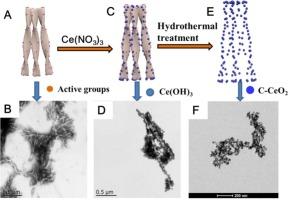Facile synthesis of chiral C-doped cerium oxide nanoparticle assemblies in the presence of phenylalanine-derived surfactant and their non-enzymatic electrocatalysis of glucose
IF 4.2
Q2 CHEMISTRY, MULTIDISCIPLINARY
引用次数: 0
Abstract
Designing the chirality of inorganic nanostructures, such as individual nanoparticles and their assemblies, will offer a new potent platform for bioanalysis, chiral catalysis and chiral sensors etc.. Herein, the chiral C-doped cerium oxide nanoparticle assemblies were successfully synthesized by inducing an amino acid-based surfactant (N-(2-hydroxydodecyl)-L-phenylalanine) in a hydrothermal process. The chirality of the C-CeO2 nanoparticle assemblies originates from the asymmetric geometries of CeO2 nanoparticles, which were assembled by the doped linkage of carbon species from the synchronously decomposed surfactant during the hydrothermal process. The resultant C-CeO2 nanoparticle assemblies demonstrate unique chiral features, and their chirality can be regulated by adjusting the surfactant concentration. Based on the chiral selectivity, CeO2, as a chiral artificial nanoenzyme, can show excellent electrocatalytic activity in the process of glucose oxidation. The chiral C-CeO2 nanoparticles modified electrode could detect glucose in the wide range of 0.60 μM–2.00 mM, and a low detection limit of 1.359 μM (S/N = 3). Furthermore, the as-fabricated electrodes demonstrated good stability and an interference-free performance in real samples. The chiral C-CeO2 nanomaterials will promise the novel application in the field of chiral catalysis, enantiospecific separation and chiral electrochemical sensors.

手性c掺杂氧化铈纳米粒子在苯丙氨酸衍生表面活性剂存在下的简单合成及其对葡萄糖的非酶电催化作用
设计无机纳米结构的手性,如单个纳米颗粒及其组件,将为生物分析、手性催化和手性传感器等提供一个新的有力平台。本文通过水热法诱导氨基酸基表面活性剂N-(2-羟基十二烷基)- l -苯丙氨酸,成功合成了手性c掺杂氧化铈纳米颗粒。C-CeO2纳米粒子组合的手性源于水热过程中同步分解表面活性剂中碳种的掺杂链组装而成的CeO2纳米粒子的不对称几何形状。所得的C-CeO2纳米粒子具有独特的手性特征,其手性可以通过调节表面活性剂的浓度来调节。基于手性选择性,CeO2作为一种手性人工纳米酶在葡萄糖氧化过程中表现出优异的电催化活性。手性C-CeO2纳米粒子修饰电极对葡萄糖的检测范围为0.60 μM - 2.00 mM,最低检出限为1.359 μM (S/N = 3)。此外,制备的电极在实际样品中表现出良好的稳定性和无干扰性能。手性C-CeO2纳米材料在手性催化、对映特异性分离和手性电化学传感器等领域具有广阔的应用前景。
本文章由计算机程序翻译,如有差异,请以英文原文为准。
求助全文
约1分钟内获得全文
求助全文

 求助内容:
求助内容: 应助结果提醒方式:
应助结果提醒方式:


